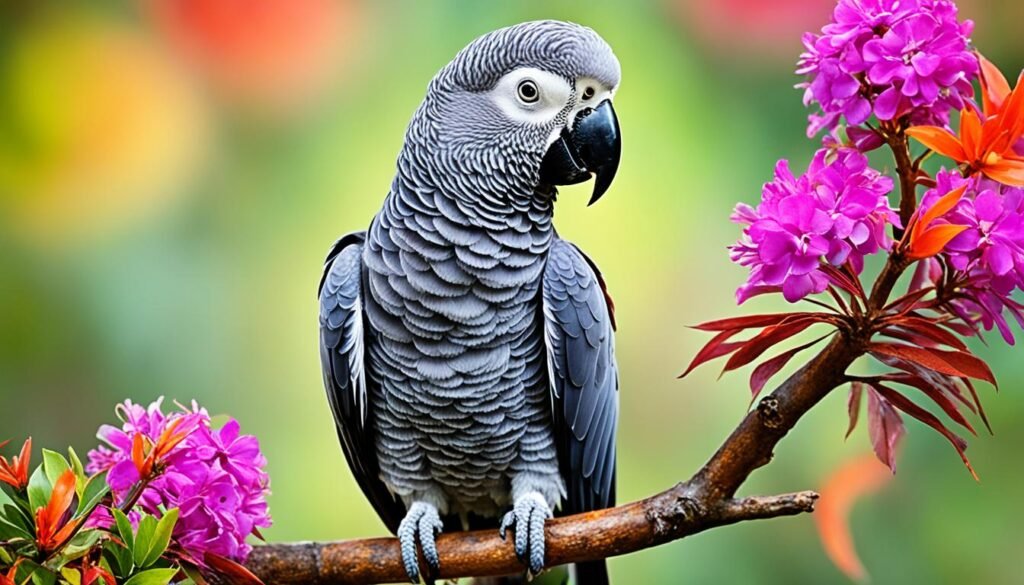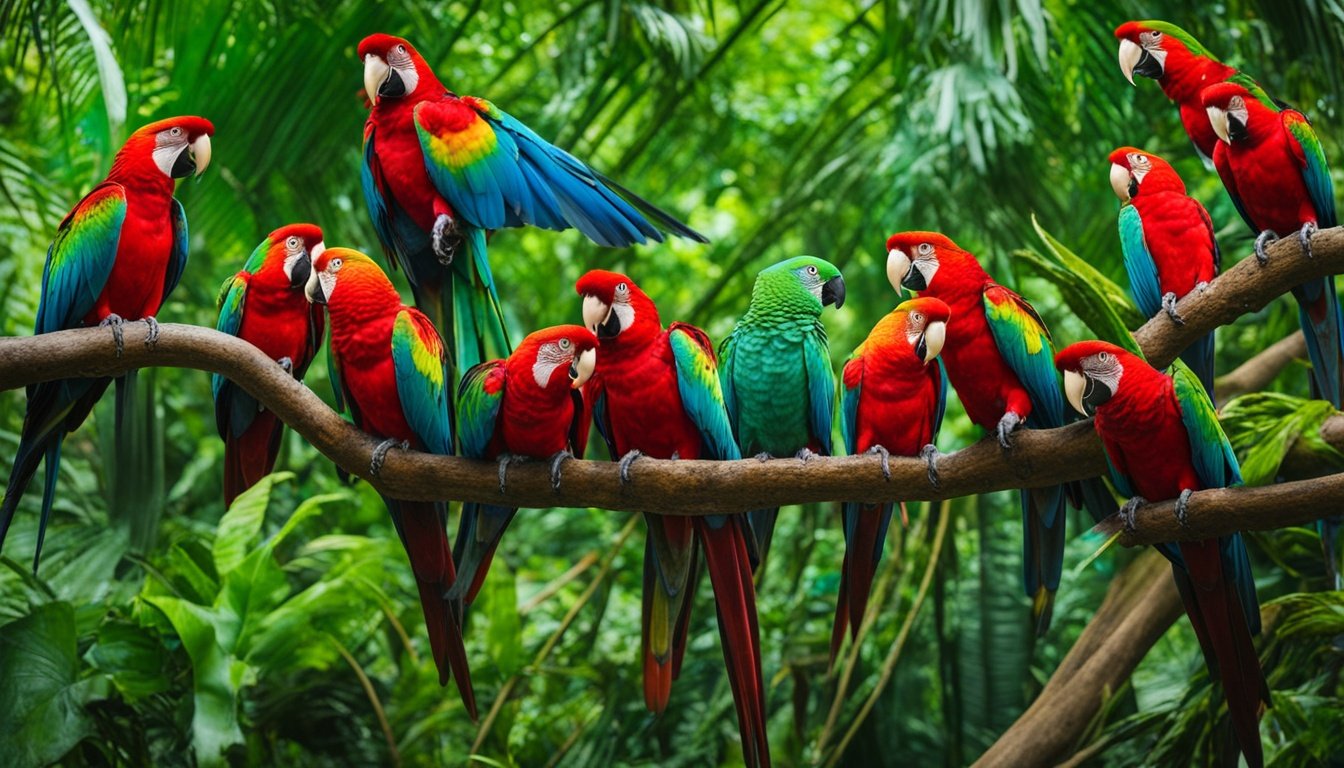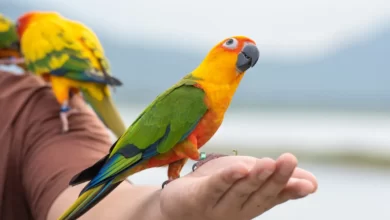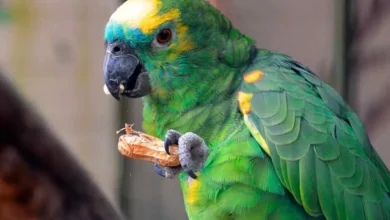Discover Parrots of Asia: Vibrant Avian Diversity
Imagine a world where vivid colors like crimson, azure, and emerald fill the sky. Welcome to the world of Asian parrots, a group that has captured the hearts of many. They are known for their beauty and diversity. Let’s explore the secrets and wonders of these fascinating birds.
In Southeast Asia, you’ll find a variety of parrot species. These include the vibrant Lories, majestic Cockatoos, stunning Macaws, and playful Parrotlets. Parrots, part of the Psittacidae family, are loved for their bright colors and ability to talk and interact with humans. As we dive deeper, you’ll learn about their unique traits, where they live, and how we can help protect them.
Captivating Charm of Asian Parrots
Parrots in Asia are famous for their bright parrot plumage and fun parrot personalities. They come in many colors, like the bright reds, blues, and greens of Lories, and the striking blacks and whites of Cockatoos. Their lively movements and playful actions draw in birdwatchers and zoo visitors.
Vibrant Plumage and Lively Personalities
Asian parrots are a sight to behold, with their parrot vocalizations and parrot intelligence making them even more interesting. These birds are not just beautiful but also very smart. They show off their parrot behavior in many ways, like strutting and playing.
Interaction and «Talking» Abilities
Asian parrots are known for their ability to talk and interact with humans. They can learn to mimic human speech, creating a special connection with their owners. Their smartness and desire to connect with people make them great pets for bird lovers and those looking for a unique companion.
The bright parrot plumage, lively parrot personalities, and amazing parrot vocalizations and parrot intelligence of Asian parrots have made them a favorite in the region. Both in the wild and in captivity, these birds continue to amaze and delight everyone who meets them.
Zoogeographical Zones and Parrot Distribution
Alfred Russel Wallace, a famous naturalist, described how parrots spread across Asia. He divided the region into three main areas: the Asian, Australian, and Wallacea zones.
Asian Zoogeographical Zone
Mainland Southeast Asia, the Philippines, and four main Indonesian islands make up the Asian zone. It’s home to many parrot species like the Ring-necked Parakeets and Blue-rumped Parrots. This area is known for its rich parrot diversity and unique habitats.
Australian Zoogeographical Zone
Australia and New Guinea are part of the Australian zone. Here, you’ll find parrots such as the Eclectus Parrots and King Parrots. These birds have adapted to the diverse landscapes, making this area a paradise for bird lovers.
Wallacea: The Transitional Area
Wallacea lies between the Asian and Australian zones. It’s where species from both regions meet, including the Hanging Parrots and Racket-tailed Parrots. This area acts as a bridge, allowing parrot species to mix and exchange.
| Zoogeographical Zone | Key Parrot Species | Characteristics |
|---|---|---|
| Asian |
| Diverse parrot species found in mainland Southeast Asia, the Philippines, and major Indonesian islands. |
| Australian |
| Highly diverse parrot fauna, including unique species found in Australia and New Guinea. |
| Wallacea |
| A transitional zone between the Asian and Australian zoogeographical realms, hosting a mix of species from both regions. |
Alfred Russel Wallace’s work showed how Asia’s zoogeographical zones shape parrot diversity. Each zone has its own special birds, making the region a treasure trove of zoogeographical zones and parrot distribution. This includes Asian parrots, Australian parrots, and the unique Wallacea area.
Parrots of Asia: Diverse Species
The Asian region is home to a wide variety of parrot species. Each one has its own unique traits and ways of adapting. From the bright Ring-necked Parakeets to the stunning Blue-rumped Parrots, these birds are a sight to behold.
Ring-necked Parakeets and Blue-rumped Parrots
The Ring-necked Parakeets, also known as Rose-ringed Parakeets, are found in parts of Asia. This includes India, Sri Lanka, and the Middle East. They stand out with their green feathers and a pink and black ring around their necks.
The Blue-rumped Parrots are mainly in the Philippines and nearby islands. They have a mix of green and blue colors. A bright blue patch on their rump makes them a joy to watch.
Hanging Parrots and Racket-tailed Parrots
The Hanging Parrots live in the Wallacea region and have a unique way of life. These small, green parrots with a red rump hang upside down from trees to sleep. They are found in the same area as the Racket-tailed Parrots.
The Racket-tailed Parrots are known for their colorful feathers and long, racket-shaped tails. They come in shades of green, blue, and red.
These parrot species show the amazing variety of birds in Asia. From the colorful Parakeets to the Hanging Parrots and Racket-tailed Parrots, Asia’s parrots are a true wonder of nature.
Aviculture and Captive Breeding Efforts
The practice of aviculture, or breeding birds in captivity, has greatly helped save many parrot species. Over the last 50 years, these programs have grown. They now help both the pet trade and protect threatened species. Parrots are loved for their bright colors, complex behaviors, and how they connect with people.
Zoos and bird parks in Southeast Asia are key in breeding and showing parrot species. They help in the conservation of these remarkable birds. But, the quality of breeding places for parrots can differ. Some are better than others, as seen by parrot breeders.
Some parrot breeding places are like puppy mills. Many parrots live in small cages with little to do. They don’t have enough space to fly or use proper perches and toys. This can make them stressed and agitated, especially when their babies are taken for breeding.
The conservation challenges for parrots are big. Habitat loss and local trade are the main threats. Captive breeding has helped, but the demand for parrots as pets is still a problem. We need both captive and wild conservation efforts to save these birds.
There are between 358 and 402 parrot species worldwide, with 358 being the most accepted number. Before 1992, there were 358 species, and the wild bird trade stopped in the USA. Europe banned the trade in 2007. Now, 20 parrot species are critically endangered, 33 endangered, and 53 vulnerable in the US.
The most common birds in rescues are the Moluccan Cockatoo, Yellow-naped Amazon, African Greys, and macaws. These endangered parrot species could soon be very rare in captivity. This shows how important conservation efforts are.
Jurong Bird Park: Showcasing Asian Parrots
Jurong Bird Park in Singapore is a top spot for bird lovers. It’s one of the biggest bird collections in Southeast Asia. Here, over 5,000 birds from 400 species live, including many parrots from Asia and other parts of the world.
Macaw Exhibits and South American Species
The park’s main attraction is the Macaw aviaries. Here, you can see the bright colors and unique personalities of Macaws. These include the rare Blue-throated Macaw and the huge Hyacinth Macaw.
There are also many South American parrots like Amazons, Conures, and Caiques. These birds show the amazing variety of birds from the neotropical region.
African Parrots and Iconic Grey Parrots
The park also focuses on African parrots. You can see the Grey Parrots, known for their ability to «talk» and their fun personalities. These exhibits highlight the colorful diversity of African parrots.
Jurong Bird Park is important for parrot conservation. It offers exhibits and programs that teach visitors about these birds. This helps people understand and support the protection of parrots.
Threats to Wild Parrot Populations
Parrots are fascinating birds, but they face many threats. These threats are both in Asia and around the world. Habitat loss and deforestation are big concerns. Human activities, like building and infrastructure, take over their homes.
Tropical forests in Southeast Asia are being cut down. This has made many parrot species lose their homes. As a result, their numbers are going down a lot.
Habitat Loss and Deforestation
Deforestation is a big threat to parrots everywhere. About half of the Earth’s land is now used by humans, leaving less than half of natural habitats. This has hit parrot species hard, with nearly one third in decline and 28% or 111 out of 398 parrot species at risk.
Agriculture is a main cause of deforestation. 74% of the world’s most threatened bird species, including 1,087 species, face threats from agriculture. Parrots are especially at risk, with about 30% of their populations affected by agriculture.
Climate Change and Environmental Factors
Climate change and pollution also harm parrot populations. They disrupt breeding cycles and food sources. Global wildlife has dropped almost 70% in 50 years, and 13% of birds, 1,469 species, are threatened with extinction.
We need to act to save parrots. This means protecting their habitats, using land wisely, and conservation efforts. This is key for parrots in Asia and globally.
Parrots of Asia: Illegal Trade and Conservation
Parrots are popular pets, but their trade is often illegal and dangerous. Criminal groups make a lot of money from selling parrots, like the African Grey Parrot, for up to $30,000 each. This illegal trade and habitat loss have made many parrot species endangered.
During the COVID-19 pandemic, rare Indonesian birds were sold for just 250,000 rupiah ($15). The illegal wildlife trade is huge, worth up to $23 billion a year. It affects one out of four bird and mammal species worldwide.
Conservation efforts are key to stop the illegal trade and save parrots in Asia. In 2016, Facebook teamed up with the WWF to cut wildlife trade by 80% in four years. By 2019, Facebook banned live animal trade on its platform, allowing only verified sellers with good reasons.
But, the fight against illegal bird trade is tough. In Sulawesi, protected species like the yellow-crested cockatoo are being sold openly on social media. Mining towns like Morowali are centers for illegal bird trade. Conservation agencies need to do more to stop this.
The illegal trade of parrots is a big problem that needs everyone’s help. We must raise awareness, enforce laws, and find sustainable solutions. Together, we can protect these amazing birds for the future.
| Statistic | Value |
|---|---|
| Illegal wildlife trade worldwide | Up to $23 billion annually |
| Global bird and mammal species affected | 1 out of 4 |
| Reduction in wildlife trade on Facebook | 80% within 4 years |
| Parrot eggs smuggled and hatched | 26 out of 29 eggs, resulting in 24 chicks |
| Poaching of yellow-naped Amazon nests | 90% of wild nests |
The illegal trade and habitat loss threaten many endangered parrot species in Asia. We need to work together to stop this. Awareness, enforcement, and sustainable solutions are key to protecting these amazing birds for the future.
Avian Diversity in Southeast Asian Zoos
Zoos in Southeast Asia are key in showing off the area’s rich bird life, including parrots. These places might not be as famous worldwide as others, but they’re big on breeding and saving birds.
In places like Malaysia, Singapore, and Indonesia, you’ll find parrots from the bright Lories and Cockatoos to the Hanging Parrots and Racket-tailed Parrots. These birds teach people about parrots and help save them by breeding and researching.
A study showed birds make up over a third of zoo animals, making them the most common. But Southeast Asia has only 17 out of 550 modern zoos, which is a big problem. It’s predicted that one-third of bird species could disappear by 2100.
In Thailand, the first public zoo, Dusit Zoo, opened in 1938. Zoos there are split into three types: accredited, government, and private, each with its own goals. A survey of 55 Thai zoos from July 2020 to July 2022 showed how many bird species they have, showing their role in saving birds worldwide.
| Zoo Characteristics | Findings |
|---|---|
| Bird Species Diversity | 249 bird species, with 149 of them not native to Thailand |
| Correlation between Bird and Mammal Diversity | Positive correlation observed |
| Factors Influencing Bird Diversity | No significant correlation found with entry ticket price, GDP of the province, or size of the zoo |
| Differences in Bird Diversity by Zoo Type | Significantly different bird species diversity between accredited, government, and private zoos |
| Non-native Bird Species | Private zoos had the highest number of non-native bird species |
The study showed what affects the types of birds in Southeast Asian zoos. It’s mainly about what birds are available, if it’s legal to keep them, and luck. Zoos in places with lots of species, like Thailand, can breed rare birds and help with conservation.
Indonesia has the second-most threatened bird species in the world, with 146 as of September 2015. The demand for songbirds puts a lot of pressure on these populations. The Asian Songbird Trade Crisis Summit in 2015 aimed to stop illegal trade by monitoring markets, taking action, and making people aware.
Global Popularity and Demand for Pet Parrots
Parrots have won the hearts of people worldwide with their bright colors, charming personalities, and amazing voices. The African Grey Parrots are especially popular for their ability to talk like humans and form strong connections with their owners.
Because of their popularity, over a million African Greys have been taken from the wild. This has hurt their numbers a lot. The love for parrots as pets and the illegal trade threaten their survival. We need good rules and sustainable ways to help them.
African Greys: The «Best Talkers»
The African Grey Parrot stands out with its grey feathers and bright red tail. It’s known as the «best talker» among parrots. These birds can mimic many sounds, from simple words to full conversations.
Many African Greys have been taken from Africa illegally. Over 40 years, about 12 million were smuggled out. This has caused big declines in their numbers. In Togo, they’re extinct, and in Ghana, their numbers dropped by 99%.
Parrots are very popular pets, but the illegal trade is a big problem. We need good rules and sustainable ways to protect these amazing birds. This will help keep them safe in the wild.

| Parrot Species | Estimated Wild Population Decline | IUCN Status |
|---|---|---|
| African Grey Parrot | 99% in Ghana, Extinct in Togo | Vulnerable |
| Lorius garrulus | 30% to 50% over 25 years | Vulnerable |
| Parrot Species in Indonesia | 34% of 89 species traded, including Critically Endangered, Endangered, and Vulnerable species | Various, including Least Concern, Near Threatened, and Threatened |
Conservation Challenges and Sustainable Solutions
Protecting parrots in Asia and around the world is a big task. We face many challenges, like habitat loss and deforestation. These problems come from human actions, destroying where parrots live. Climate change, pollution, and diseases also threaten them.
The illegal trade in parrots makes things worse. People want these birds as pets, which drives the trade. We need to tackle these issues head-on to save parrots.
We need to protect their homes and use land wisely. Captive breeding programs and strict laws against illegal trade are key. These steps help parrots and support their natural habitats. Captive breeding keeps their genetic diversity alive.
It’s also vital to fight the illegal parrot trade. We must stop poaching and break up illegal supply chains. Education and awareness can also help reduce demand. Together, we can save these amazing birds.





